One hundred years ago, Tokyo businessman Takeshi Yamashita dreamed of starting a company that, instead of relying on imports, would design and manufacture entirely Japanese-made microscopes.
It was his desire to create that was the genesis of Olympus, which he founded on October 12, 1919. Originally called Takachiho Seisakusho, our company in its early inception specialized in thermometers as well as microscopes. Six months after establishing Olympus, Yamashita and his engineers achieved his original objective with the Asahi microscope. Throughout three decades of struggle, exacerbated by the Great Kanto Earthquake and World War II, Yamashita led Olympus in innovating award-winning microscopes to help advance life science research and practice. Immediately following World War II, the business flourished, and we became one of the first companies to resume its post-war factory operations and make a move toward modernization. While there have been many innovation milestones in Olympus’ 100-year history, our mission has always been driven by Takeshi Yamashita’s original vision to “create something truly original and bring value to society.” | 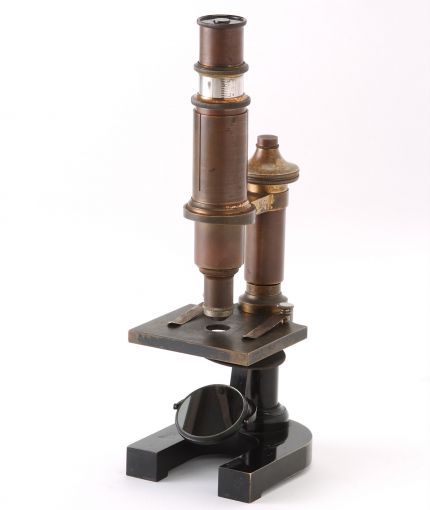 Launched in 1920, the Asahi microscope was our first product |
100 Years of Optical Innovation
In 1950, Olympus made a breakthrough—we used our growing expertise in optics to develop a gastrocamera for clinical use, so physicians could look inside their patient’s stomach using a minimally invasive technology.
During the 1960s, we became one of the industry’s preeminent manufacturers of optical solutions, with innovations in medical devices, consumer cameras, and industrial tools. All the while, we kept working to improve our products’ ease of use and functionality, focusing on the needs of our customers. In the 1970s, to meet the evolving demands of the microscope industry, we developed three upright microscope series targeting specific applications, including research, clinical laboratory, and education.
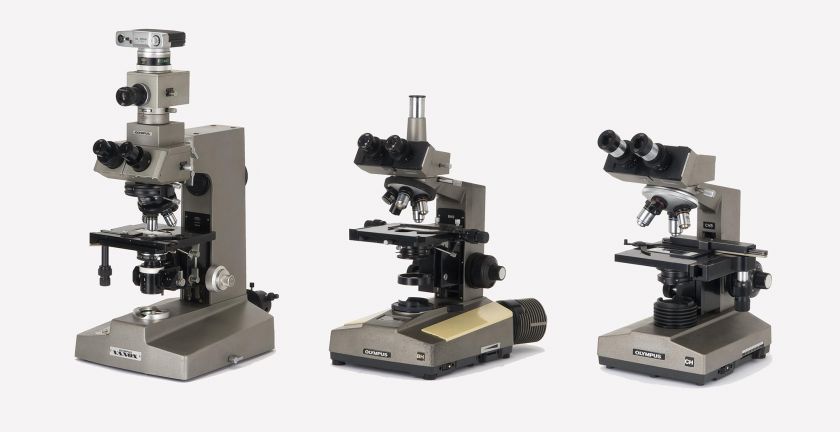
Upright microscope series (left to right) launched in the 1970s—the AH Series (1972), the BH Series (1974), and the CH Series (1976)
A platform, or main body, was designed for the flagship of these series, the VANOX AH microscope. This platform was used as the base for subsequent models. The needs of different applications could be met simply by changing the model’s components. This platform marked the beginning of our move toward modular microscopes with customizable components for different applications. Today, we continue to manufacture modular microscopes so customers can get the most out of their system.
Our original modular microscopes offered greater flexibility and ease of use to meet the ever-changing needs of customers. The multipurpose BH microscopes, for example, enabled users to switch the head or lens to change the observation method. Options included polarization, phase contrast, differential interference, and simple transmission fluorescence microscopy.
Designed for versatility, the modular CH series enabled simple polarization, drawing, or epi-illumination (metallurgical) microscopy—making these products well-suited for biological research, clinical laboratory work, and industrial applications.
100 Years of Customer-Focused Advances
In the 1980s, Olympus incorporated an autofocus (AF) function into our high-performance microscopes. At the time, this AF feature was advanced technology. A motorized mechanism simplified the time-consuming process of bringing an object into focus. Autofocus was a big leap forward in microscope usability since users could quickly achieve clear focus on a sample and concentrate on observation.
This decade also saw the advent of configurable microscope systems. These versatile microscopes offered long barrel (LB) objective lenses (1X–100X oil) that could be used for brightfield, polarization, fluorescence, and phase contrast microscopy. This functionality paved the way for advanced stereo microscopes that could visualize the 3D structure of larger samples, such as an embryo or electrical circuit.
100 Years of Technological Evolution
The 1980s and 90s brought a wave of technological innovations. Advances in fluorescent protein labeling, which culminated in the application of green fluorescent protein (GFP) for live cell imaging, spurred product development. GFP revealed dynamic processes inside living cells that were previously invisible. This meant life sciences researchers required observation techniques with higher sensitivity and lower phototoxicity. We answered this demand with new confocal microscopes, live cell imaging (LCI) systems, and other spatial imaging solutions.
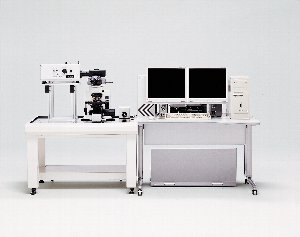 An acquisition system of the computer era, FLUOVIEW 300/500 confocal laser scanning microscopes were capable of producing 2048 × 2048-pixel images | During the early 90s, we developed our first commercial confocal microscopes: the LSM-GB upright microscope and the LSM-GI inverted microscope. Using a confocal microscope, biologists can visualize the spatial distribution of organic structures and molecules. This allowed them to identify whether the target organism exists inside the cell. Technologies like fast optical scanning, dim light detection, photon counting, and optical selection glass filters with a high-precision multilayer coating technique empowered our microscopes’ capabilities. In the same decade, two significant life science series were launched: the FLUOVIEW microscope series and the DP microscope-dedicated digital camera series. FLUOVIEW laser scanning confocal microscopes scanned with an excitation laser to produce 3D images. DP series microscope cameras captured images and saved them on digital media, making them easier to save and share. These series were cornerstones in our solutions aimed at meeting the demands of advanced life science research. |
This period also saw rapid advances in digital technology. With the computer revolution in full swing, product development in many industries benefited from automation facilitated by microprocessors, CPUs, GPUs, and digital memory.
100 Years of High-Quality Images
In keeping with our dedication to high-quality images, we developed and launched a line of universal infinity system (UIS) objectives in the early 90s. These infinity-corrected objectives enabled users to insert multiple optical components in the light path, which significantly expands the microscopes’ capability. For instance, you could add an analyzer or a DIC prism to enable polarization without interfering with the image quality. Or, you could add an epi-illuminator and fluorescence cubes to change it into a fluorescence microscope.
UIS optics not only significantly improved the quality of observation images but also universalized the objectives used for all our microscopes.
About ten years later, the next generation UIS2 series objectives were released. Still popular today, UIS2 objectives provide clear, high-resolution images, low autofluorescence, and a longer-wavelength capability. The eyepieces offer higher transparency and are made with lead-free glass, so they are more environmentally friendly.
The early 2000s were marked by the launch of a twin-laser scanning FLUOVIEW model. Simultaneous scanning using twin lasers, one for imaging and the other for stimulation, heightened the sensitivity level and enabled real-time fluorescence imaging. This innovation enabled researchers to observe biological phenomena in real time.
This type of observation was given another boost with the launch of our first multiphoton laser scanning microscope three years later. This microscope offered reduced background noise as the multiphoton laser scanning excited only the optically focused region of the fluorescence molecule. Neuroscience researchers could use the microscope to peer deeper into the brain than with earlier models.
100 Years of Sophisticated, User-Oriented Design
Even before ergonomics became a fundamental principle of product design, we looked for ways to make our microscopes more comfortable to use. Pathologists and cytologists screening specimens in laboratories for long hours motivated the launch of a microscope with a low-position stage and tilting binocular. These features enabled physicians to keep their arms resting on the table while working and tilt the eyepieces to keep their head in a more comfortable position.
Also in the 2000s, pathologists and researchers were given another tool with the ability to digitize entire slides using our whole slide imaging (WSI) scanner. Digitization of glass slide images enabled pathologists and cancer researchers to share and discuss data remotely with colleagues, as well as analyze them quantitatively to get more precise pathological insights. Researchers and pathologists could also access digital slide data anytime without being hindered by the lack of physical space to store patient slides. Since 2010, we’ve put design and functionality under the microscope, so to speak. We developed an LED light source that features high luminosity, true-to-life color, and an extended life of 50,000 hours, saving researchers money and downtime. The BX46 microscope exemplified our commitment to user comfort. Every component involved in its operation was ergonomically designed. Innovative features, such as the moveable nosepiece and ultralow stage, helped ease the physical demands of repetitive routine microscopy. The BX53 microscope for clinical pathology, launched in 2017, has illumination control functionality that synchronizes the brightness with the objective magnification. This provides yet another way to achieve more comfortable and less time-consuming microscopic observation. | 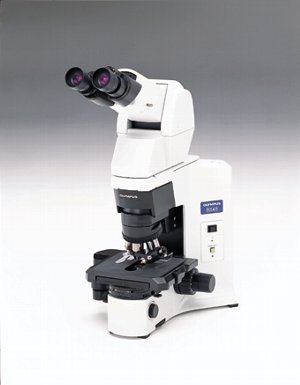 Designed for user comfort, the Olympus BX45 microscope featured a novel Y-shaped body |
Other notable innovations included:
- An interchangeable modular deck system for inverted microscopes, accommodating more diverse samples and a wider variety of life science applications.
- The launch of cellSens image analysis software, featuring two modes: a simple and intuitive interface for clinical use and advanced parameters for high-end research image analysis.
100 Years of Proud Service to the Scientific Community
Technological advances in this decade have significantly improved imaging speed and quality in the laboratory. For researchers, scientific CMOS (sCMOS) image sensors offering high quantum efficiency and super resolution microscopy have been enormously beneficial. In the clinical domain, the turnaround time for laboratory testing has grown shorter as diagnoses are increasingly molecular and gene-based, which are less time-consuming.
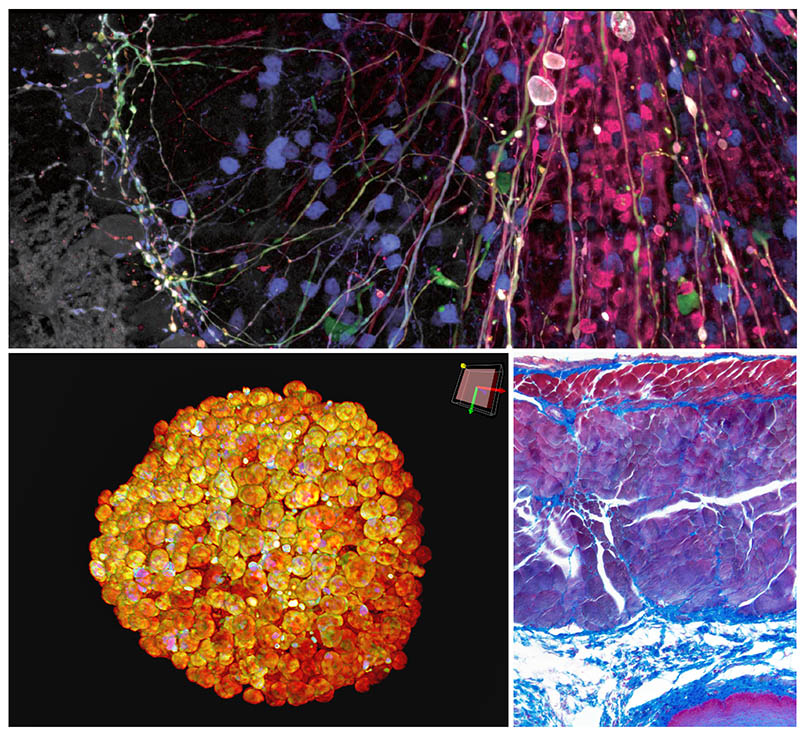
Top: Image of Brainbow AAV transfection of Purkinje cells, amplified with antibodies. Purkinje cell somata, dendrites, and axons are visible, as well as some aspecific stainings of granule cells acquired by the FV3000 microscope. Bottom left: Cleared spheroid of HT-29 cells stained with DAPI (nuclear) acquired by the Olympus IXplore Spin system. Bottom right: Azan stained captured by the DP74 digital microscope camera.
In the late 2000s, modern scientists needed new microscope features for advanced scientific observation and research. For instance, faster imaging was needed to observe faster phenomena. There was also a need for dimmer imaging to observe weaker signals, view more delicate samples, and perform more extended observation of live cells. Scientists also required more precise spectral resolution to visualize multiple genes and proteins to reveal the entire pathway of biological phenomena.
To meet these demands, we launched the FLUOVIEW FV3000 laser scanning confocal microscope in 2016. The FV3000 series features high-quality optics, high-sensitivity, high-speed multichannel imaging with macro-to-micro capabilities, and a workflow-based intuitive user interface. The frame is modular and flexible for varying applications and budgets. Scientists can choose from a simple, minimal configuration to fully customized advanced imaging.
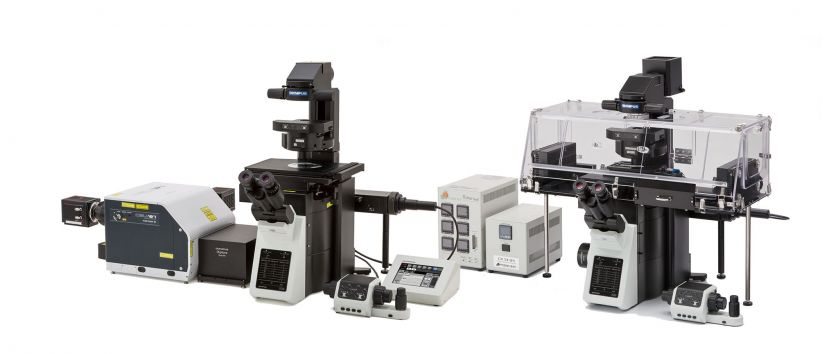
Offering multiple configurations, the IXplore series are solution-based systems
A year later, Olympus introduced the IXplore system. Enabling researchers to choose the system best-suited for their observation needs, there are six IXplore configurations available: a standard model for simple documentation and five specialized options for motorized multidimensional observation, live cell imaging, total internal reflection fluorescence (TIRF), spinning disk confocal, and super resolution.
Going beyond the optical limit with super resolution has become the new reality in microscopy. Olympus Super Resolution (OSR) is available on the IXplore SpinSR10 microscope system. It has modes for widefield fluorescence, confocal imaging, and super resolution. These features enable researchers to observe deeper into their specimens, faster and more easily.
Over the past century, Olympus technology has benefitted various applications with higher resolution and faster operation. These innovations have helped revolutionize how science is approached and defined. Our researchers continue to develop and innovate imaging systems for both clinical and research laboratories. We’re always searching for faster, more powerful, and even more ergonomic solutions. This spirit is exemplified by new X Line objectives that, thanks to an innovative new manufacturing process, offer simultaneously improved numerical aperture, image flatness, and chromatic aberration correction for outstanding image quality.
The creative spirit of our founder, Takeshi Yamashita, lives on in all of our endeavors and is exemplified in our “True to Life” promise to deliver smart, innovative solutions that change the world around us and contribute to a better society for all.
Stay up to date with our future innovations by subscribing to the Discovery Blog.

